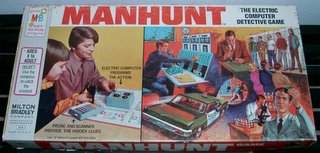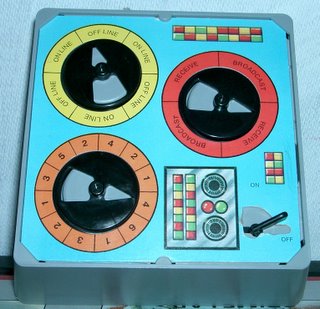Manhunt: The Electric Computer Detective Game (TM)

Manhunt: The Electric Computer Detective Game was published in 1972 by the Milton Bradley Company.
 This is a great game simply by dint of the sheer number of props that come included. You've got the "electric computer [that] programs the action", a probe and scanner that "provide[s] the hidden clues", several colorful player tokens in the shape of vintage sedans, clue sheets to keep track of ... well clues, a deck of cards for use with the probe and scanner, a detective's handbook (where a budding young detective keeps his or her clue sheet), a book of "suspect data", and of course, the game board itself.
This is a great game simply by dint of the sheer number of props that come included. You've got the "electric computer [that] programs the action", a probe and scanner that "provide[s] the hidden clues", several colorful player tokens in the shape of vintage sedans, clue sheets to keep track of ... well clues, a deck of cards for use with the probe and scanner, a detective's handbook (where a budding young detective keeps his or her clue sheet), a book of "suspect data", and of course, the game board itself.The box cover does an excellent job selling the game. It clearly states the object of the game -- "Use the computer to catch the criminal" -- thus eliminating the possibility of any misunderstandings about the serious task ahead of you and your opponents. And showing what I cleverly deduce to be a brother and sister happily playing the game, as well as the numerous references to the "electric computer", definitely put any parent at ease by telling them that not only is this is a family-suitable game but it is also an excellent way to expose their children to the burgeoning world of computers! The right half of the cover summarizes the exciting game action that awaits you quite well -- you'll be calling cars back to HQ, searching for and analyzing clues, identifying suspects, and chasing them down at breakneck speed in an attempt to crush them between your police cruiser and a brick wall ... actually, I'm not too sure about that last part. The included instructions don't make any specific mention of it. Undoubtedly I am simply missing the alternate rules section.
Essentially, the game plays much like the more well known Clue(TM). Players travel around the board visiting crime scenes, stakeouts, etc in order to gather clues. Once a player has collected enough clues, they write the name of their suspect on their clue sheet and check their answer. If they're wrong, they're out of the game, and no one knows what the poor sap's guess was.
 The star of the game, as you might have guessed, is the "electric computer". It determines each player's movement by simulating a die roll (1d6), controls when a player is allowed to search for clues, and in certain situations allows one player to view another player's collection of clues. Quite capable. The power source? One D-size battery. Even though my many years of technical schooling and long history of computer usage has enabled me to reverse-engineer this marvel of ages past, I won't divulge any of its secrets here.
The star of the game, as you might have guessed, is the "electric computer". It determines each player's movement by simulating a die roll (1d6), controls when a player is allowed to search for clues, and in certain situations allows one player to view another player's collection of clues. Quite capable. The power source? One D-size battery. Even though my many years of technical schooling and long history of computer usage has enabled me to reverse-engineer this marvel of ages past, I won't divulge any of its secrets here.The scanner has a slot were you insert a scanner card, which is a sort of rudimentary punch card. The probe allows a player to check for holes in the card (hidden by the scanner), i.e., a clue! The row and column where a "clue" is found determine what the clue actually is. Each scanner card can be used 3 times (once each for a robbery, a murder, and a swindle). Before the game begins, you decide what type of crime you're attempting to solve, and the Read Out to Clue Scanner (and Suspect Data) booklet help you interpret your clues.
Simply reading through the booklet of suspect data is quite enlightening, giving you a glimpse into the underworld that criminals inhabit. The first thing we can learn is that depending on the type of crime commited, all criminals share certain characteristics. Take robbery, for instance. If you know someone with some or all of the following, keep your valuables hidden: speaks with an accent (apparently any accent will do), has a visible scar, has a tatoo, and/or walks with a slight limp (presumably from all that climbing through windows and what not). Swindlers, on the other hand, most often live in motels and drink heavily. The game creators spared no effort is creating names for all their soon-to-be-caught criminals. Thiefs are given away by such monikers as Dora Jar and Luke Sharp. And if you meet a woman named Ella Minate, Kay Poot, or Barb Wyre, well watch your back because she's likely a murderer. Milton Bradley isn't kidding when it describes itself as the "key to fun and learning". This game and a few choice episodes of Perry Mason should be mandatory learning tools for anyone interested in law enforcement.

0 Comments:
Post a Comment
<< Home